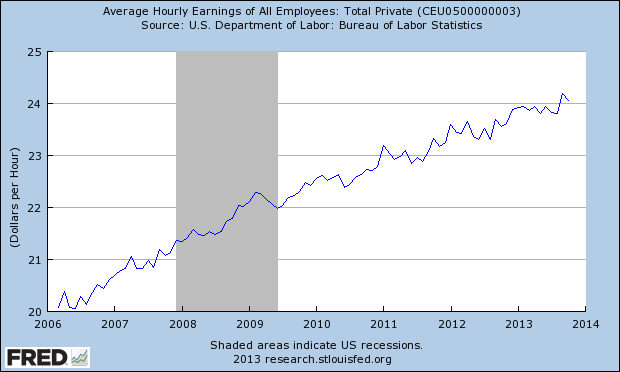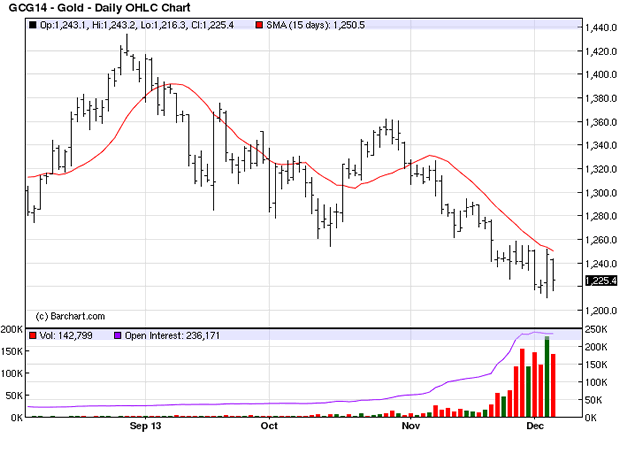The Kress Cycle and the Fate of the Middle Class, And China's Gold Appetite
Politics / Cycles Analysis Dec 06, 2013 - 07:05 AM GMTBy: Clif_Droke
 Just how much pain has the middle class suffered in the last four years? The data is quite conclusive: the pain has been harsh.
Just how much pain has the middle class suffered in the last four years? The data is quite conclusive: the pain has been harsh.
According to government statistics, wages for the middle class have shrunk appreciably in the past decade. The Census Bureau points out that the typical middle class household made $51,017 this year, roughly the same as the typical household made a quarter of a century ago. Adjusted for inflation, that's a decline in living standards too big to ignore.
Providing further insight into the middle class plight, in 2010 the U.S. Commerce Department published a report about what it would take for different types of families to reach the historical U.S. middle class -- which it defined as a house, 1-2 vehicles, an annual vacation, decent health care and enough savings to retire and contribute to the college education of one's children. Its conclusion was that the middle class has become much more exclusive than it used to be. "Even two-earner families making almost $81,000 in 2008 -- substantially more than the family median of about $51,000 reported by the Census -- would have a much tougher time acquiring the attributes of the middle class than in 1990," one analyst concluded.
Additional perspective on the growing gap among the classes can be found in a 56 percent jump in the cost of housing since 1990, a 155 percent leap in out-of-pocket spending on health care and the double-digit increase in the cost of college. "Either we define the middle class down a couple of notches," stated one reporter, "or we acknowledge that the middle class isn't in the middle anymore."
The doleful plight of the middle class has been a recurring theme among journalists for much of this year. Just this week, for instance, the Washington Post highlighted a speech by President Obama which emphasized the "dangerous and growing inequality" between America's highest earners and the rest. The president's speech was rich with platitudes but poor on solutions.
To take another recent example, Rana Foroohar, writing in the Dec. 2 issue of Time, opines that despite an abundance of monetary liquidity, "we have a real-economy-growth problem." Foroohar acknowledges that the Fed's monetary policies have benefited the top quarter of American households, which hold most of the country's equity assets. Yet "they have done much less for the rest," she contends, "people who continue to struggle with flat wages and higher than normal unemployment." Boston Fed President Eric Rosengren admitted as much when he stated, "If you don't have a house or stock, you don't benefit as much" from QE.

The need to do more to stimulate the economy and revive the middle class has been the excuse behind attempts at actually increasing monetary stimulus. Former Treasury Secretary Larry Summers, in a recent speech before the International Monetary Fund, warned that the U.S. might be stuck in a "secular stagnation." He suggested that this slump isn't a result of normal business cycles but could be a potentially permanent condition. The solution he offered to "fix" this problem was the introduction of negative interest rates by the Fed.
Others have picked up on this theme. Miles Kimball, an economist at the University of Michigan, has suggested placing sharply negative interest rates on bank deposits, which is tantamount to charging customers for keeping money in the bank. "Paper currency could still continue to exist," Kimball was quoted as saying in the Dec. 1 issue of Businessweek. "But prices would be set in terms of electronic dollars (or abroad, electronic euros or yen), with paper dollars potentially being exchanged at a discount compared to electronic dollars." Theoretically this would put pressure on consumers to spend before their money loses value, thus providing a boost to the economy according to this line of thinking.
While economists offer up schemes to get the average consumer buying again, the underlying cause of the problem continues to be ignored. An overlooked factor behind the decline of the middle class is the long-term economic rhythm, or Kress cycle. The 60-year cycle of inflation and deflation provides an almost perfect parallel of the middle class plight since 1954. When a new 60-year cycle took off in 1954, so did the fortunes of a majority of Americans. The 60-year cycle is divided into two 30-year cycles. The first half of the 60-year cycle is typically inflationary and is conducive to rising wages and an increasing standard of living. The second half of the cycle is at first disinflationary, then deflationary.
By examining the current 60-year cycle which began in 1954 one can easily see that the first 30-year period from '54 until 1984 was a time of expansion for the middle class. Probably no greater period of unbridled economic success has been experienced by most Americans than during this period. By contrast, the period from 1984 until 2014 - when the cycle bottoms - has been one of declining economic fortunes, especially the last 10 years.
It was Machiavelli who said that when a problem becomes so big that everyone can see it, the time for remedies has passed. The problem of the shrinking middle class can't be solved by direct political action; the time is much too late for such remedies. The only possible hope for revival is a resurgent economy in the years following next year's 60-year cycle bottom.
It is worth noting that Mr. Kress, the namesake of the cycle, himself didn't believe that the upcoming 60-year cycle bottom would result in a meaningful resurgence of the middle class. Instead he predicted the further establishment of socialist political policies aimed at increasing, not decreasing, economic inequality among the classes.
Kress also referred to his long-term cycle as a "Revolutionary Cycle," pointing out that the bottom of this cycle frequently coincides with the advent of major social/military/economic revolution. Kress emphasized that the Industrial Revolution which gave birth to the U.S. middle class was a product of the long-term cycle bottom of 1894. Many commentators believe that a global economic empire, or world government, will become a reality within our lifetime. The words of author Felix Markham in his seminal work, "Napoleon," provide context to this line of thought. Speaking of Napoleon's attempt at creating a world empire, he wrote:
"But it is hardly conceivable that the...world empire which appeared to be within his grasp could have lasted more than a few years. The forces at work in Europe [in the 19th century] would have shattered it into fragments - the rise of the middle class, fostered by Napoleon as the basis of his power, and soon to be immensely accelerated by the spread of the industrial revolution. And it was this class which was to be the spearhead in the demand for national self-determination and parliamentary government."
In other words, Markham is saying that a strong middle class is inimical to a highly centralized autocratic, or socialist, government. Within this context the decline of the U.S. middle class may be considered by the ruling class as an expedient toward greater political centralization.
In the final analysis, the problem of the shrinking middle class is so extensive and entrenched that any political solution is likely to be ineffective. The time for remedies is when a problem is still in its infancy; when it has become entrenched the trend must be allowed to run its course, at the end of which the problem will terminate and thereby create its own solution through the process of time. Economic trends are products of the long-term cycles and attempts at forcing cures to a problematic trend usually succeed only in exacerbating the problem. The best that the middle class can hope for is that time itself will work out a solution agreeable to its survival.
Gold
China's appetite for gold has proven to be insatiable as the latest supply/demand statistics bear out. It was recently reported that China has imported 31.19 tons of gold from Hong Kong in October, the second highest level in history. China has imported more than 100 tons of gold each month in the last six months, according to Sharps Pixley. It's also anticipated that Chinese gold demand will continue to pick up before the lunar New Year at the end of January 2014. It's further expected by analysts that China will overtake India as the largest consumer in the world in 2013 once the final numbers are in.
Notwithstanding China's torrid pace of gold purchases, demand from Western countries continues to be muted by comparison. For now, this is the driving force in the supply/demand picture for gold as U.S. and European investors are more influential in setting the tone for gold prices. As long as equities continue to make strides, gold as an investment will most likely continue to play a distant second fiddle as bear market conditions remain in place for the yellow metal.
Gold remains under its downward-trending 15-day moving average which means the immediate-term downtrend is still intact. A 2-day higher close above the 15-day MA would allow gold a temporary respite from selling pressure and perhaps a 1-2 week relief rally. Until such a breakout occurs, however, the trend remains down. We're still in an all-cash position as we await the next confirmed trading signal from our indicators.

Kress Cycles
Cycle analysis is essential to successful long-term financial planning. While stock selection begins with fundamental analysis and technical analysis is crucial for short-term market timing, cycles provide the context for the market's intermediate- and longer-term trends.
While cycles are important, having the right set of cycles is absolutely critical to an investor's success. They can make all the difference between a winning year and a losing one. One of the best cycle methods for capturing stock market turning points is the set of weekly and yearly rhythms known as the Kress cycles. This series of weekly cycles has been used with excellent long-term results for over 20 years after having been perfected by the late Samuel J. Kress.
In my latest book "Kress Cycles," the third and final installment in the series, I explain the weekly cycles which are paramount to understanding Kress cycle methodology. Never before have the weekly cycles been revealed which Mr. Kress himself used to great effect in trading the SPX and OEX. If you have ever wanted to learn the Kress cycles in their entirety, now is your chance. The book is now available for sale at:
http://www.clifdroke.com/books/kresscycles.html
Order today to receive your autographed copy along with a free booklet on the best strategies for momentum trading. Also receive a FREE 1-month trial subscription to the Momentum Strategies Report newsletter.
By Clif Droke
www.clifdroke.com
Clif Droke is the editor of the daily Gold & Silver Stock Report. Published daily since 2002, the report provides forecasts and analysis of the leading gold, silver, uranium and energy stocks from a short-term technical standpoint. He is also the author of numerous books, including 'How to Read Chart Patterns for Greater Profits.' For more information visit www.clifdroke.com
Clif Droke Archive |
© 2005-2022 http://www.MarketOracle.co.uk - The Market Oracle is a FREE Daily Financial Markets Analysis & Forecasting online publication.



